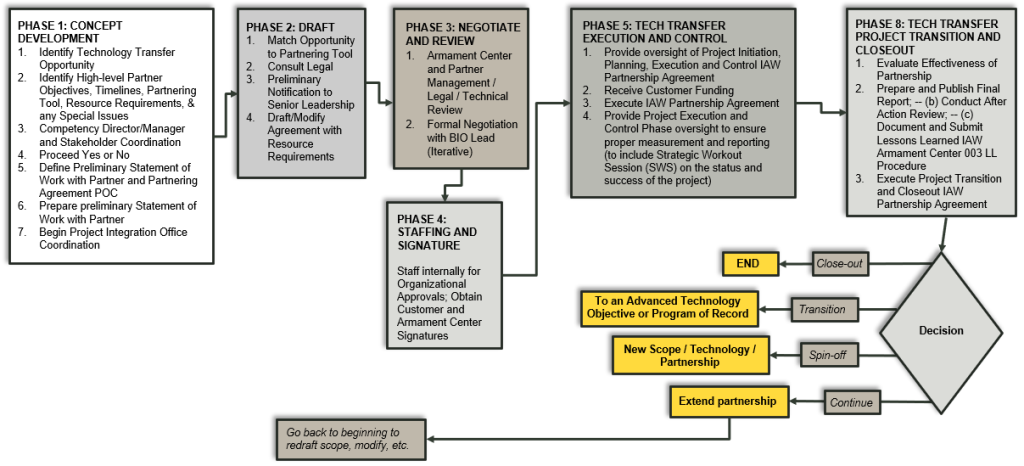
Collaboration with business, academia, individuals and other U.S. government agencies, and even with foreign governments, is a critical part of how the Armaments Center accomplishes its mission.
The Armaments Center collaborates with different entities in different ways. Click on the black rectangles below to learn about the various collaboration topics or to make contact. Further down the page is access to our listings of patents and facilities that are available for cooperative arrangements as well as a terminology page to provide clarity for some of the vernacular.
A separate listing of contacts can be found HERE
TECHNOLOGY TRANSFER OFFICE
The Armaments Center Technology Transfer (T2) Office supports the Armaments Center mission by utilizing T2 tools to develop domestic and international partnerships with a wide variety of organizations (industry, academia and other government organizations, etc.) to accelerate the development and transition of new technologies for our nation’s warfighters. The Armaments Center’s research investments have also demonstrated commercial spin-off benefits for the nation’s civilian economy. The Armaments Center’s partners, utilizing various technology transfer mechanisms, receive the benefits of the Armaments Center’s multi-discipline expertise, vast experience and unique facilities.
The Technology Transfer Office manages the process by which knowledge, facilities or capabilities are shared with partners to further develop and exploit the technology to fulfill public and private needs.
The Armaments Center uses Technology Transfer to leverage the expertise, technology and resources of other organizations and share its own to support the Mission and remain on the cutting-edge of technology.
The Armaments Center has a robust Technology Transfer Program. It uses a growing variety of T2 tools, which include Cooperative Research and Development Agreements, Engineering Services Agreements, Educational Partnership Agreements, use of Partnership Intermediaries, and Patent Licensing Agreements and Test Services Agreements, to name a few.
- T2 supports a strong industrial base, which DoD may utilize to support its needs and the economic security of the United States by transferring the benefits of federally funded R&D to commercial applications (spin-off).
- T2 provides innovative partnering methods for DoD to acquire the latest technology from private sector sources who may not normally do business with the federal government through standard procurement processes (spin-on).
- T2 identifies technologies, capabilities, tools, and techniques primarily developed for military purposes, yet viable enough commercially to support adaptation and production for industrial or consumer uses.
- T2 can be reached by e-mail at usarmy.pica.devcom-ac.mbx.t2@army.mil
TECHNOLOGY TRANSFER PROCESS
Within the Armaments Center, many collaborative efforts fold into what we call the Technology Transfer Process. Technology Transfer is the process by which existing knowledge, facilities, or capabilities developed by one organization is shared with partners to further develop and exploit the technology to fulfill public and private needs. This helps the U.S. Army remain on the cutting-edge of technology. The diagram below illustrates the steps in the Armament Center’s T2 partnership agreement process.

DEPARTMENT OF DEFENSE ORDNANCE TECHNOLOGY CONSORTIUM
The Department of Defense Ordnance Technology Consortium/National Armaments Consortium is sponsored by the Office of the Secretary of Defense and is utilized by all services and defense agencies to design, develop and demonstrate prototypes for armaments. DOTC offers government customers a better way of doing business through streamlined acquisition and collaboration across a broad spectrum of industrial and academic partners. DOTC envisions an integration of government, industry, and academia into a single enterprise, executing joint and co-funded initiatives, sharing and developing goals and objectives, resources and assets, and utilizing existing personnel, facilities and equipment. The mission of the DOTC is to enhance our warfighters’ lethality, survivability and combat effectiveness. This is accomplished by facilitating the industrial and academic research, development and technology demonstrations needed to advance and expand our military technological superiority
- Rapid technology transfer to the Warfighter
- Advocates a critical mass of world-class technologists
- Leverages government, private industry and academia R&D resources
- Promotes nontraditional defense contractor involvement
- Promotes innovation
To learn more about DOTC NAC, please visit HERE
SMALL BUSINESS INNOVATIVE RESEARCH
The Armament Center participates in the Army SBIR program to solicit innovative research and development proposals from small technology companies. Three times a year, the Armament Center submits technology requirements, SBIR “topics,” for publication in the DoD SBIR broad agency announcements. The Armaments Center uses its technology transfer toolkit to help facilitate the transition of phase II programs to phase III military and commercial applications. The Armament Center’s on-site business incubator, the Picatinny Technology Innovation Center, has become home to several SBIR companies. This demonstrates how the Armament Center’s technology transfer efforts, coupled with state and local government partnerships, complement the SBIR Program. Small businesses who seek to collaborate with the Armaments Center via a SBIR should reach out to the Army SBIR Program Management Office.
Please visit HERE
INDEPENDENT RESEARCH AND DEVELOPMENT REVIEWS
The Armaments Center’s IR&D review process fosters communication between industry and the Armaments Center while advancing the “Better Buying Power 3.0” initiatives. Through the IR&D process, the Armaments Center and its PEO/PM customers work together to determine needs and identify compatible and competent industry partners that can address these needs. The Armaments Center clearly communicates the requirement gaps to matching industry partners at precisely the most productive moment: prior to their future year IR&D project planning cycle. These targeted communications encourage unique partnerships with companies focusing in technology areas with the most potential impact to the Army’s needs.
For information on IR&Ds, please e-mail: usarmy.pica.devcom-ac.mbx.ir-and-d@army.mil
INTERNATIONAL COOPERATION
The Armaments Center makes full use of international collaborative activities with allied defense establishments and academic institutions to leverage our mission funded research investments. The Armaments Center has a vigorous international program with the lead on numerous active and proposed bilateral agreements, as well as support to other Department of the Army and Department of Defense agencies in their cooperative programs. These agreements enable cooperative research programs with allies in selected technology areas where their strengths complement the Armaments Center and offer good leveraging opportunities.
Allies who wish to collaborate with the Armaments Center should contact the following e-mail address: usarmy.pica.devcom-ac.mbx.t2@army.mil
INNOVATION AND STRATEGIC RELATIONSHIPS DIVISION
Enhancing the value of Armaments Center’s innovation efforts through strategic communication and collaboration, identifying opportunities to accelerate the adoption of emerging technologies for enhanced lethality and future armaments programs. We welcome new partnerships with government, industry, and academia. Submit your innovative concepts via the Armaments Center’s Broad Agency Announcement for “Emerging Weapons and Munitions Systems and Soldier Lethality Related Technologies” (W15QKN-21-R-0ER7 on www.sam.gov) or email devcom-ac-isr-g9army.mil@army.mil
WARFIGHTER CENTRAL (CONTACT FOR DEPLOYED UNITS, LAW ENFORCEMENT & FIRST RESPONDERS)
Warfighter Central’s mission is to fuse operational context, global threat intelligence & emerging requirements to inform technologies & products that meet Warfighter needs throughout continuous transformation.
Operational context: military knowledge and experience — strategic, operational & tactical
Global threat intelligence: Integrating with G2 and intelligence communities
Concepts & Requirements: Warfighter needs from those in contact — deliberate-to-conceptual
Inform: Strategic foresight, strategic planning, workforce development & business opportunities
Deployed units, inter-agency law enforcement and first responders should contact Warfighter Central via the following address: AFC-DEVCOM-AC-WFC-RFI@army.mil
CONTINUED SUPPORT FOR CONTRACTS, DRAWING REQUESTS AND OTHER COLLABORATION
Once a part of a formal collaboration with the Armaments Center, you may require information about Army systems or components. To request drawing of technical data packages, please e-mail: usarmy.pica.devcom-ac.mbx.tdp-support@army.mil
For other support, please select from the most appropriate contact in the listings above.
UNSOLICITED PROPOSALS
The Armaments Center fosters and encourages submission of unsolicited proposals that offer unique and innovative technological promise to accomplish its mission. An unsolicited proposal is defined in FAR 2.101 as “a written proposal for a new or innovative idea that is submitted to an agency on the initiative of the offeror for the purpose of obtaining a contract with the government, and that is not in response to a request for proposals, Broad Agency Announcement, Small Business Innovation Research topic, Small Business Technology Transfer Research topic, Program Research and Development Announcement, or any other government-initiated solicitation or program.” Advertising material, commercial item offers, or contributions, as defined in 15.601, or routine correspondence on technical issues, are not unsolicited proposals. Generally, a valid unsolicited proposal must:
- Describe an innovative and unique product/process
- Be independently originated and developed by the offeror
- Be prepared without government supervision, endorsement, direction, or direct government involvement
- Include sufficient detail to permit a determination that government support could be worthwhile, and the proposed work could benefit the agency’s research and development or other mission responsibilities
- Not be an advance proposal for a known agency requirement that can be acquired by competitive methods, and
- Not address a previously published agency requirement.
To submit unsolicited proposals, please e-mail: usarmy.pica.devcom-ac.mbx.tilo@army.mil
FACILITIES
For a complete list of facilities available via Test Service Agreement, see our Facilities Page.
PATENTS
For a list of patents available for Patent License Agreements, see the Patents page.
TERMINOLOGY
See the Terms and Concepts page for more on the frequently used collaboration terminology.
